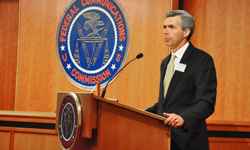From the FCC
 At 3:15 p.m. on Aug. 2, FCC Public Safety and Homeland Security Bureau Chief Admiral Jamie Barnett and Jeff Cohen spoke to APCO members and conference attendees about the issues currently pending at the Commission.
At 3:15 p.m. on Aug. 2, FCC Public Safety and Homeland Security Bureau Chief Admiral Jamie Barnett and Jeff Cohen spoke to APCO members and conference attendees about the issues currently pending at the Commission.
Barnett began by immediately addressing the disagreement between the public safety community and the FCC regarding the amount of spectrum required to create a National Public Safety Broadband network and the reallocation of the D Block.
“I would like to address the D Block right off the bat,” he said. “We have a disagreement over the same thing, I think. We have a common goal of seeing a nationwide interoperable public safety broadband network. In the past year, there has been significant progress on that. I would have loved to be in concert with the public safety community. Based on the recommendations, they have concerns about the cost of the network if the spectrum is reallocated [to public safety]. One block to interoperability is if we cannot afford the network. APCO and PSA [have] worked hard and effectively to create a dialogue on the D Block.”
Barnett moved on to discuss the positive aspects that have come out of the recently released National Emergency Communications Plans, including ERIC (Emergency Response Interoperability Center), the future creation of a public safety advisory committee to drive the vision of the center and Next Generation 9-1-1 technologies.
APCO Regulatory Counsel Robert Gurss conducted the panel and raised other public safety issues, such as narrowbanding, rebanding and priority access for public safety.
The question was raised about the legality of public safety having priority access to broadband communications systems during a crisis. “LTE has priority access built into it, and that would be absolutely perfect for public safety,” said Barnett. “With regard to the legality, it seems pretty straightforward to put that as a condition for the licensee of the D Block. We think it is possible from a legal standpoint in the proposed rulemaking. One aspect could be that there would be compensation for the use of the network.”
On narrowbanding, Barnett said that they did not believe the Jan. 1, 2013, narrowbanding deadline to 12.5 kHz or equivalent for bands below 512 MHz would be pushed back. However, the issue of enforcement has yet to be addressed by the Commission. According to Cohen, the Commission is in the process of assessing where the country stands now before addressing enforcement.
Regarding location accuracy for E9-1-1, Barnett said that it was a high priority for the Commission. Cohen said, “We recognize that there has been great progress and applaud APCO and NENA for the joint agreement. We know there are still issues out there. … I think we have a good plan moving forward. Hopefully, we will resolve this proceeding and take steps forward.”
After the session concluded, APCO Member Ralph Gould said, regarding the D Block, “It’s an election year; if we don’t get it done now, we go to court.”
About the Author
Natasha Yetman is associate editor of APCO’s Public Safety Communications. Contact her via e-mail at yetmann@apcointl.org.

